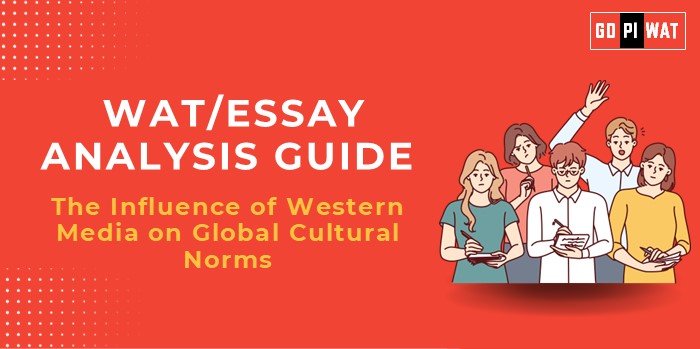📋 Written Ability Test (WAT) / Essay Analysis Guide on “The Influence of Western Media on Global Cultural Norms”
🌐 Understanding the Topic’s Importance
This essay topic addresses the far-reaching impact of Western media, relevant to B-school students as it intersects with global business, branding, and consumer behavior. Media influence affects societal values and presents a nuanced issue of globalization vs. cultural identity.
📝 Effective Planning and Writing
⏳ Time Allocation: Plan (5 minutes), Write (20 minutes), Review (5 minutes).
💡 Preparation Tips: Gather data on Western media’s market share, understand local-global cultural dynamics, and explore cases of both cultural adaptation and resistance.
✒️ Introduction Techniques for Essays
- 🔄 Contrast Introduction: “While Western media promotes ideals of freedom and individualism, it often overlooks the rich diversity of non-Western cultures.”
- 🛠️ Solution-Based Introduction: “With increasing Western media influence, countries are finding ways to balance cultural integrity with openness.”
- 📜 Historical Introduction: “The global appeal of Western media, from Hollywood to social media, shapes cultural norms worldwide—a phenomenon rooted in over a century of media globalization.”
📚 Structuring the Essay Body
- 🏆 Achievements: Western media fosters cultural exchange and sets standards in technology and storytelling.
- ⚖️ Challenges with Comparative Analysis: The dominance of Western culture may dilute local values; South Korea’s success in cultural promotion (e.g., K-pop) demonstrates an effective countermeasure.
- 🔮 Future Outlook: As global media evolves, expect a blend of Western and local media that respects cultural diversity while fostering exchange.
💡 Concluding Effectively
- ⚖️ Balanced Conclusion: “Western media has created a global platform for shared stories, but preserving cultural diversity is essential for true representation.”
- 🌏 Global Comparison Conclusion: “While Western media’s influence is unmatched, countries like South Korea and India show that a balance between global and local cultures is achievable.”
📊 Analyzing Successes and Shortcomings
- 🏅 Key Achievements: Wide cultural reach, innovation in media technology, promotion of values like individualism and free expression.
- ⚠️ Ongoing Challenges: Risk of cultural homogenization, local culture suppression, imbalance in global media representation.
- 🌍 Global Context: Countries are increasingly leveraging local media (e.g., Hallyu in South Korea) to counterbalance Western influence.
📈 Recommendations for Sustainable Progress
- 🌐 Promotion of Cultural Diversity: Encourage local content on global platforms.
- 🤝 International Collaborations: Foster cross-cultural media projects.
- 🧠 Media Literacy Programs: Help audiences understand cultural influences and maintain a balanced perspective.
📝 Sample Short Essays
- 🔍 Balanced Perspective: “Western media’s influence permeates global culture, creating both opportunities for exchange and risks of cultural erosion. For balanced growth, fostering diverse voices in media is essential.”
- ⚙️ Solution-Oriented: “With Western media as a dominant force, countries must innovate to protect their cultural heritage. Co-productions and content quotas are effective strategies to balance influence.”
- 🌟 Global Comparison: “While Western media sets global trends, the popularity of K-pop highlights that local culture can also gain international acclaim, proving that cultural diversity thrives even under global influences.”


